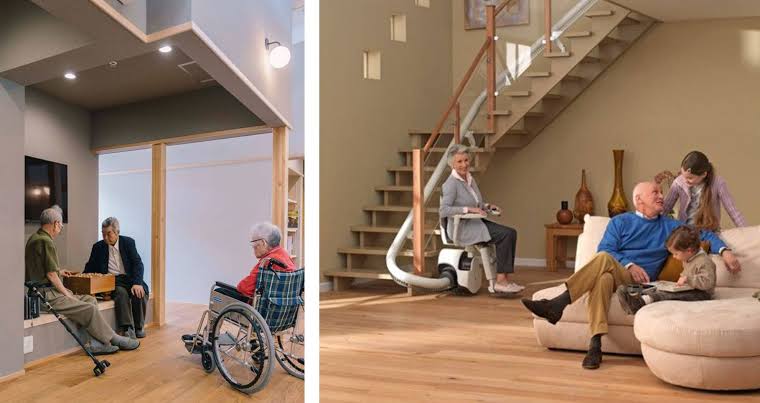
As our loved ones age, ensuring their living environment supports their needs becomes crucial. Designing a senior-friendly home involves more than just aesthetics; it’s about creating a space that promotes safety, independence, and comfort. Whether you’re planning a renovation or moving into a new place, here are key considerations to keep in mind for designing a home that caters to seniors.
1. Prioritize Accessibility
One of the first things to consider in a senior-friendly home is accessibility. Seniors often face mobility challenges, so it’s essential to design spaces that accommodate these needs:
- Wide Doorways and Hallways: Ensure doorways and hallways are wide enough to accommodate wheelchairs or walkers. Ideally, doorways should be at least 36 inches wide.
- No-Step Entries: Avoid steps at entrances. Ramps or zero-step entries are better suited for those with limited mobility.
- Handrails and Grab Bars: Install handrails in hallways and grab bars in bathrooms, especially near the toilet and in the shower or bathtub. These additions provide extra support and stability.
2. Enhance Bathroom Safety
Bathrooms are often the most dangerous rooms in the home for seniors, so special attention is needed:
- Non-Slip Flooring: Choose slip-resistant flooring materials to reduce the risk of falls. Consider using textured tiles or vinyl options designed for wet areas.
- Walk-In Tubs or Roll-In Showers: Opt for a walk-in tub or a roll-in shower with a built-in bench. These features provide easier access and reduce the risk of slipping.
- Adjustable Shower Heads: Install handheld shower heads and adjustable mounts to allow for easy use while seated or standing.
3. Optimize Lighting
Good lighting is essential for safety and comfort:
- Bright, Even Lighting: Use bright, evenly distributed lighting to reduce shadows and improve visibility. Consider installing dimmable lights to create a cozy atmosphere when needed.
- Motion-Sensor Lights: Place motion-sensor lights in key areas such as hallways, bathrooms, and stairways to ensure that lights turn on automatically when someone approaches.
- Night Lights: Install night lights in bedrooms, hallways, and bathrooms to help prevent disorientation during nighttime trips.
4. Choose Comfortable and Supportive Furniture
Furniture selection plays a significant role in a senior’s comfort and safety:
- Ergonomic Design: Select chairs and sofas with proper lumbar support and high, firm cushions to make sitting and standing easier. Avoid furniture that is too low or too soft.
- Adjustable Beds: Consider adjustable beds that can be raised or lowered to make getting in and out of bed more convenient. These beds also help with various health conditions like acid reflux or back pain.
- Easy-to-Reach Storage: Ensure storage areas like shelves and cabinets are within easy reach. Use pull-out shelves or drawers to reduce the need for bending or stretching.
5. Simplify Daily Living
Making everyday tasks easier can significantly improve a senior’s quality of life:
- Voice-Activated Technology: Incorporate smart home technology, such as voice-activated assistants, to control lights, appliances, and other devices. This technology can help seniors manage their environment with minimal physical effort.
- Easy-to-Use Appliances: Choose appliances with simple controls and large, easy-to-read buttons. Consider appliances that are designed with senior safety in mind, like refrigerators with auto-close doors or microwave ovens with large digital displays.
- Lever Handles: Replace traditional door knobs with lever handles. They are easier to operate, especially for individuals with arthritis or reduced hand strength.
6. Create a Safe and Inviting Outdoor Space
An accessible outdoor space can provide a refreshing change of scenery:
- Level Pathways: Ensure walkways and driveways are level and free of obstacles. Add ramps if necessary to facilitate easy access from the indoors to the outdoors.
- Comfortable Seating: Provide comfortable, sturdy outdoor seating options that are easy to get in and out of. Consider adding a shaded area for sun protection.
- Low-Maintenance Gardens: Opt for low-maintenance landscaping that requires minimal upkeep. Raised garden beds or container gardens can allow seniors to enjoy gardening without straining their backs.
7. Plan for Emergency Situations
Lastly, prepare for emergencies by incorporating safety measures:
- Emergency Response Systems: Install a personal emergency response system (PERS) that allows seniors to call for help with the press of a button.
- Accessible First Aid Kit: Keep a well-stocked first aid kit in an easily accessible location, and ensure that seniors know where it is.
- Clear Pathways: Keep hallways and pathways clear of clutter to ensure quick and safe movement during an emergency.
In Conclusion
Designing a senior-friendly home demands careful consideration and meticulous planning. By focusing on accessibility, safety, and comfort, you can craft a living environment that meets the needs of seniors and enriches their quality of life. Whether you’re updating an existing residence or constructing a new one, these guidelines will help ensure that your home is both welcoming and accommodating for aging in place. If you’re in Utah and seeking professional assistance, local home-building companies can provide expert guidance and support in creating the ideal senior-friendly living space.
